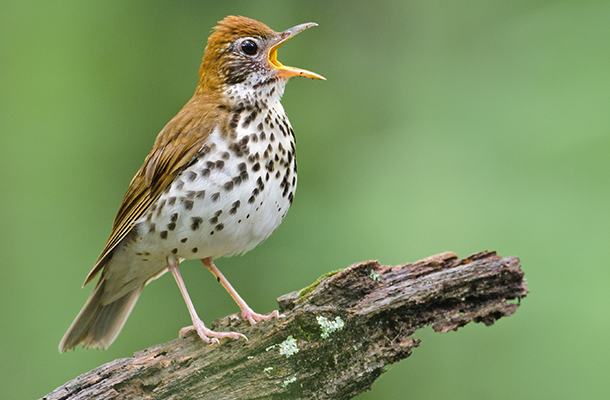North-Nesting Songbirds Tagged in Nicaragua for Monitoring by Growing Motus Network

To better inform conservation efforts, ABC and partners will track migratory movements of tagged Wood Thrushes and Louisiana Waterthrushes via the Motus wildlife tracking system. Photo by Ed Schneider
With support from the Pennsylvania Game Commission (PGC), and in collaboration with its partners at the El Jaguar Reserve, American Bird Conservancy (ABC) recently financed and assisted in placing “nanotags,” small radio transmitters, on ten Wood Thrushes and ten Louisiana Waterthrushes in northern Nicaragua. Both songbirds nest in the United States and small portions of southern Canada but winter predominantly in Central America, southern Mexico, and, in the case of the waterthrush, the Caribbean as well.
Information gathered via the nanotags, which emit signals automatically recorded by the Motus network's growing number of receiving stations, will inform conservation initiatives to save these and other declining long-distance migrants. Motus (the Latin word for “movement”) is a program managed by Bird Studies Canada and is the central hub for detection data from more than 750 receiving stations that uses automated radio telemetry to track movements of birds, bats, and even large insects tagged with lightweight nanotags. In 2019, with funding from the Missouri Department of Conservation, ABC helped install the first Motus receiving station in Nicaragua at El Jaguar. It was just the sixth installed in Central America.
During an early 2020 visit, Andrew Rothman, ABC's Migratory Birds Program Director, also worked with the El Jaguar staff to update the station's computer system, honing how it will capture signals from tagged birds.
“The use of the Motus wildlife tracking system provides another mechanism for helping to unlock the mystery of migration and demonstrate connectivity of wintering and breeding sites,” says Rothman. “This information is key to developing meaningful conservation actions. We are excited to gather information on the birds that are wintering at El Jaguar.”
El Jaguar is a private reserve set in cloud forest within the Nicaragua Highlands BirdScape. (BirdScapes are landscape-scale areas identified by ABC that provide habitat to help sustain or recover targeted migratory bird species or populations.) There, the Motus station will capture signals from any appropriately radio-tagged bird passing or stopping nearby. The cumulative data gathered as tagged birds pass various Motus stations helps shed further light on migratory pathways, helping ABC and its partners design even more effective full-life-cycle conservation actions.
ABC hopes to help install additional stations in Central and South America, including two within the Conservation Coast BirdScape of Guatemala.
Visit motus.org for more information on the Motus tracking system.
ABC gratefully acknowledges the Missouri Department of Conservation and the Pennsylvania Game Commission for their support of this ongoing project. We would also like to thank Southern Wings, a program managed by the Association of Fish and Wildlife Agencies that facilitates state fish and wildlife agency participation in the conservation of priority migratory birds throughout their annual life cycle.
###
Media Contact: Jordan Rutter, Director of Public Relations, 202-888-7472 | jerutter@abcbirds.org | @JERutter
Expert Contact: Andrew Rothman, Migratory Birds Program Director | arothman@abcbirds.org
American Bird Conservancy is a nonprofit organization dedicated to conserving birds and their habitats throughout the Americas. With an emphasis on achieving results and working in partnership, we take on the greatest problems facing birds today, innovating and building on rapid advancements in science to halt extinctions, protect habitats, eliminate threats, and build capacity for bird conservation. Find us on abcbirds.org, Facebook, Instagram, and Twitter (@ABCbirds).


















































